
The Encyclopedia of
Home Winemaking
Pierre Drapeau and Andr Vanasse
THE ENCYCLOPEDIA OF
HOME WINEMAKING
Fermentation and Winemaking Methods
Translated by
Darcy Dunton
New
Revised
Edition

Third printing, 2005
XYZ Publishing
1781 St. Hubert Street
Montreal, (Quebec)
H2L 3Z1
Telephone: (514) 525-2170
Fax: (514) 525-7537
E-mail: info@xyzedit.qc.ca
Web site: www.xyzedit.qc.ca
International Rights: Contact Andr Vanasse, tel. (514) 525-2170 # 25
E-mail: andre.vanasse@xyzedit.qc.ca
and
Pierre Drapeau
and
Andr Vanasse
Legal deposit: 2nd quarter, 1998
National Library of Canada
Bibliothque nationale du Qubec
ISBN 0-9683601-0-6
Distributed in Canada and in the United States by:
Fitzhenry & Whiteside
195 Allstate Parkway
Markham, ON L3R 4T8
Customer Service, tel: (905) 477-9700
Toll free ordering, tel: 1-800-387-9776
Fax: 1-800-260-9777
E-mail: bookinfo@fitzhenry.ca
Typesetting concept and layout: discript enr.
Cover design: Zirval Design
Cover photograph: Ludovic Fremaux
Table of Contents
Chapter One
Grapes and Wine
Chapter 2
Fermentation
Chapter 3
Biochemical Aspects and Ecological Concerns
Chapter 4
The Basic Equipment and How to Use It
Chapter 5
The Choice of Must
Chapter 6
The Winemaking Process
Chapter 7
Measurements, Scales and Tests
Chapter 8
Grape Varieties and Home-Made Wine
The publication of this book was made possible by a grant from Mosti Mondiale Inc., importers, producers, and wholesalers of musts for home winemaking.

Mosti Mondiale Inc
6865 Route 132
St. Catherine (Quebec), Canada
JOL 1E0
Telephone: (450) 638-6380
Fax: (450) 638-7049
Internet Site Address: www.mostimondiale.com
Photos Credits
Pierre Drapeau: .
Mosti Mondiale: pages .
Lalvin: page .
Pierre Drapeau and Andr Vanasse would like to thank Darcy Dunton for her excellent translation.
They also express their deep appreciation to the staff at Mosti Mondiale, especially:
 Marc Moran, without whom this project could not have been undertaken. His enthusiasm and generous help and advice allowed this book to be completed in the best possible circumstances;
Marc Moran, without whom this project could not have been undertaken. His enthusiasm and generous help and advice allowed this book to be completed in the best possible circumstances;
 Nino Piazza, who kindly and spontaneously offered Mosti Mondiales technical assistance as well as its testing laboratories;
Nino Piazza, who kindly and spontaneously offered Mosti Mondiales technical assistance as well as its testing laboratories;
 Sigrid Gertsen-Briand, for her generous technological assistance.
Sigrid Gertsen-Briand, for her generous technological assistance.
Pierre Drapeau would like to pay a particular tribute to:
 his two most important collaborators, his wife Rita and his son Pascal, whose unstinting devotion allowed him to finish this book;
his two most important collaborators, his wife Rita and his son Pascal, whose unstinting devotion allowed him to finish this book;
 his customers, who have continually inspired him to carry out further research and to obtain the most up-to-date information to answer a thousand questions concerning the art of winemaking;
his customers, who have continually inspired him to carry out further research and to obtain the most up-to-date information to answer a thousand questions concerning the art of winemaking;
 his students, always eager to learn more and to hone their knowledge;
his students, always eager to learn more and to hone their knowledge;
 all the store-owners who have dedicated part of their lives to the defense and the dissemination of the great and noble activity that is winemaking.
all the store-owners who have dedicated part of their lives to the defense and the dissemination of the great and noble activity that is winemaking.
Andr Vanasse wishes to thank:
 Dr. Michel Vanasse, who parted (temporarily!) with his personal library collection on oenology, a vast and complex area of human knowledge.
Dr. Michel Vanasse, who parted (temporarily!) with his personal library collection on oenology, a vast and complex area of human knowledge.
The authors would like to thank the following distribution companies for providing the material for the photographs free of charge: ABC CORK, Distrivin, Divin Distribution, Microvin, Mosti Mondiale, Spagnols, Vineco International Products, Vinothque, and Wine-Art. We also thank the Microvin store, Lallemand Laboratories, and Lalvin yeast makers for providing material to illustrate this book.
CHAPTER ONE
Grapes and Wine
A t an unknown point lost in the mists of time, human A beings began to make wine from grapes. Wine is mentioned in innumerable ancient writings, including hundreds of biblical passages. The habit of drinking wine was undoubtedly acquired by the Hebrews before Moses led them from Egypt. The Egyptians, in turn, had likely been initiated to it by the Persians while the latter occupied Mesopotamia. The Persians themselves would have learned it from the Sumerians, allowing us to attribute a respectable antiquity of at least six thousand years to winemaking. The museum at the Mouton-Rothschild estate contains proof of this, with its winemaking artifacts dating from the third millenium B.C.
As to who actually discovered the secret of making wine, we can only assume that its heady delights were discovered accidentally when someone negligently left some grape juice standing too long.
However, to make wine properly, the fermentation process had to be understood scientifically. This knowledge must have developed through trial and error until the winemaking process was mastered sufficiently to produce a justifiable quantity of good wine every year.
This was achieved by techniques which are still practised today. For example, the use of sulphur (contained in sulphur dioxide) for protecting wine from contaminants and oxidation was already known to the Greeks. It is difficult to say if this practice had been handed down by more ancient civilizations. We do know, however, that sulphur was used to disinfect clothes in ancient China.
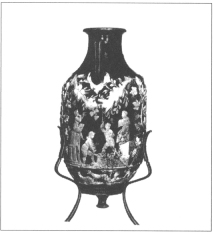
Greek amphora at the Museo Nazionale di Napoli, showing cherubs harvesting and crushing grapes.
Amphorae over a thousand years old have been recovered from the Mediterranean Sea, containing what could still be recognized as wine, showing that the ancients not only knew how to make wine, but also how to preserve it.
Does wine possess superior virtues over alcoholic beverages made from other fruits? Judging by its fame and fortune in the temperate regions of half the world, it would appear so. The reason for this is certainly related to the nature of the grape whose constituent elements are in harmonious balance, making the resulting beverage infinitely more pleasant to drink than those based on other fruit, cider for example, which has a much more acidic taste.
The following illustration gives a breakdown of the grapes different properties. The fruit, attached to the stalk (or stem), is made up of:
a) a thin outer layer, the skin;
b) an inner part (by far the most important) called the pulp, that is, the flesh of the grape;
c) the seeds, which vary in proportion according to the variety and size of the grape.

Next page
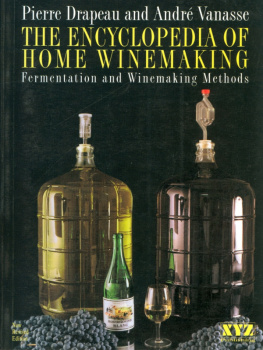

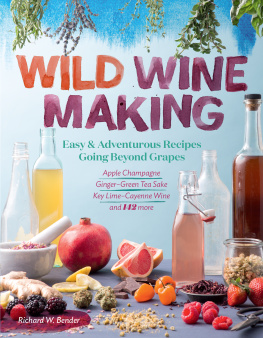
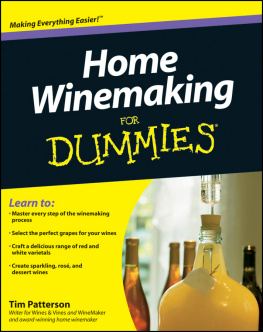
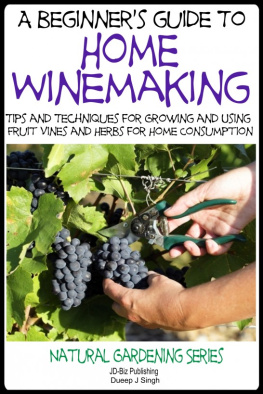

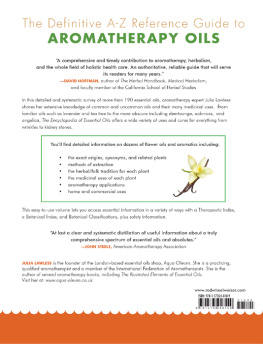



 Marc Moran, without whom this project could not have been undertaken. His enthusiasm and generous help and advice allowed this book to be completed in the best possible circumstances;
Marc Moran, without whom this project could not have been undertaken. His enthusiasm and generous help and advice allowed this book to be completed in the best possible circumstances;
